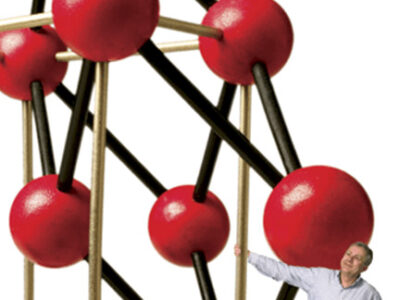Class of ’87 | Nanotechnology is the province of the tiny. Those who toil in the field tinker with atoms and molecules, the tiniest bits of matter. Its basic unit of measurement is the nanometer, which is one billionth of a meter.
The late Michele Huber EAS’87 W’87 was tiny, at least by contemporary American standards, and Bryan Giles EAS’87 W’87, her boyfriend and fiancé, wasn’t too much bigger. They were full of life and promise, and then, just after graduating from Penn in 1987, they were tragically killed in a car accident. Though they have always lived on in the minds of family and friends, their memory is now formalized in an unlikely place: a nanotechnology laboratory in the School of Engineering and Applied Science.
The Michele Huber and Bryan D. Giles Laboratory, which was dedicated in October, was funded and named by Peter Armstrong EAS’87, their classmate and close friend; facilitating the project was another classmate and good friend, Allie Rogers EAS’87 W’87, now an overseer in the engineering school. (Armstrong and Rogers have also been friends since their Penn days, and in 1993 they co-founded Triple Point Technology, a Connecticut-based company that develops software for global commodities markets. Armstrong is now the company’s principal owner, president, and CEO.)
For a funder to name a facility after friends is “very unusual,” said Eduardo Glandt GCh’75 Gr’77, dean of the engineering school, who described the lab as a “centerpiece” of the school’s efforts in nanotechnology.
“We already have a leadership role in the country in nanotechnology,” Glandt explained, but since “science never stops” and the school’s plans for a new nanotechnology building are still in the development stage, it’s vital to have smaller, state-of-the-art labs in the short run.
Heading the lab is Cherie Kagan C’91 MTE’91, an associate professor in the Department of Electrical and Systems Engineering and the Department of Materials Science and Engineering. “Cherie is a star whom we recruited, one of the leaders” in her field, noted Glandt, and “perhaps the most interactive person in the school” in terms of collaborating with faculty from other schools.
In a brief tour for the Gazette, Kagan talked about some of the work being done in the lab, and pointed out some of the lab’s high-tech gizmos—a spectrophotometer that measures the intensity of light and the absorption and reflectance of materials; an infrared spectrometer, one of whose attachments can analyze a single layer of molecules on a surface; and a “glove-box system” that allows lab workers to manipulate materials in an environment that is virtually free of oxygen and moisture.
“We’re interested in some very fundamental directions about how we manipulate matter to direct the flow of energy and the flow of charge and charge transfer,” says Kagan, “and then implementing that to engineer devices that could impact things like solar cells, or enable new kinds of devices and applications related to consumer electronics, or applications that might impact medical technologies.”
Among those present at the dedication ceremony in October were Michele Huber’s father, former Alumni Relations Director Mike Huber W’53 ASC’61, and her mother, Dorothy Mitchell Huber CW’55. Mike Huber was, understandably, delighted to have the lab named after his beloved daughter and her fiancé.
“Michele was a tiny person, and Bryan wasn’t much bigger,” said Huber, “so it tickles me, as it would have tickled them, to have a nano lab named after them.”
—S.H.



